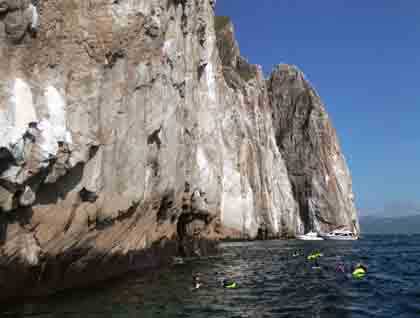Navigating towards this place took the National Geographic Islander all night due to counter currents, and as we finish our breakfast we arrive on time. This is one of the oldest islands in the archipelago. It has been formed by the union of two volcanoes, giving its shape to San Cristobal Island, which has a population of six thousand people. We had a wet landing on a golden sand beach at the northern most part named Punta Pitt.
Thousands of volcanic ash eruptions have formed the mountains here, and we began our hike at the base of Punta Pitt. From this golden sand beach we headed up through a place that could be considered a small river when it rains more than usual, but now it is dry. It’s quite a challenge to go all the way up and across, and along the way we were able to find red footed boobies and a few San Cristobal mockingbirds. The vegetation looks green at this time of the year because we are in the humid rainy season, but this week it didn’t rain. Then we got back to the beach just in time before the sun gets too hot and our explorers are able to swim cool down and relax.
It was time to get back to the National Geographic Islander to move on to the next destination, Leon Dormido, a volcanic formation. This place is the home of some species of sharks and this is the place where our guests are going to do snorkeling. Once in the water it is nice to get close to the walls because there is submarine life that has adapted to this environment, growing barnacle and starfish. Different kind of fish, turtles, and sharks can be seen here.
After this experience we got back to the National Geographic Islander to get ready for circumnavigating Leon Dormido. While the sun sets on the horizon we get to see this formation and some birds nesting and flying along the panorama. This been a colorful end for a great week, full of unique moments that have opened our eyes to the great world that we live in and that we need to take care. It is our little home, and it is the only one.







